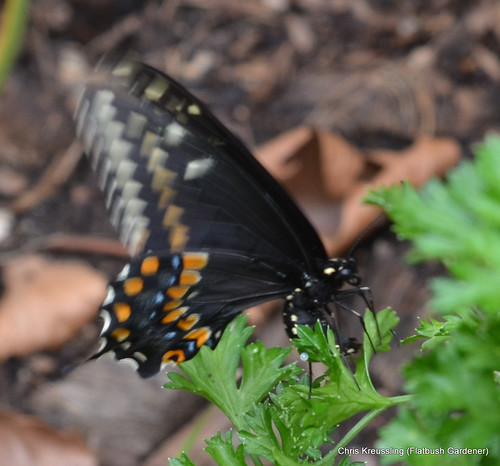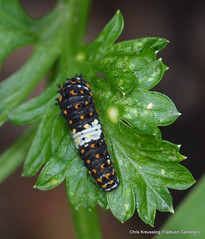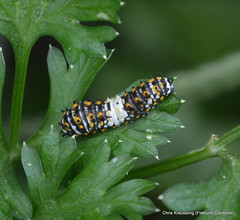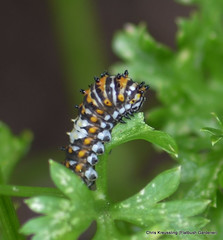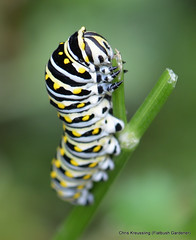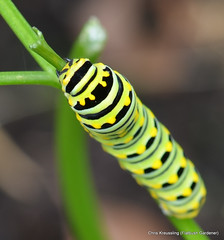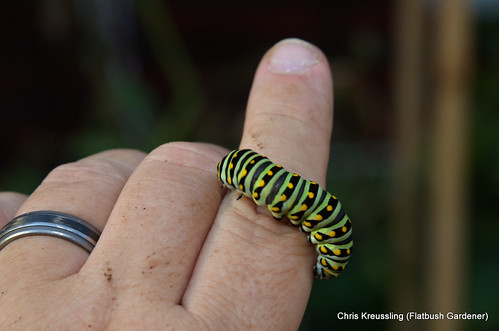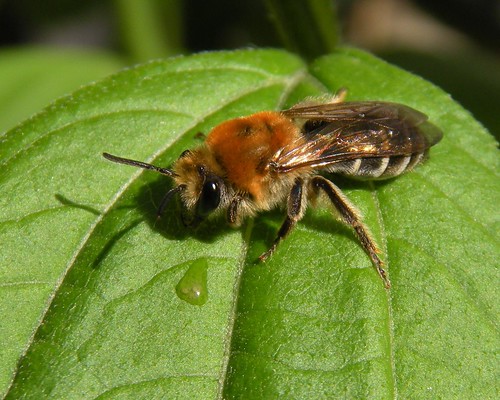Update 2012-09-10: Only one caterpillar remains.
The morning of the day we left on our last road trip – which led us to the Adirondack Hudson, among other places – I saw this in one of our vegetable beds: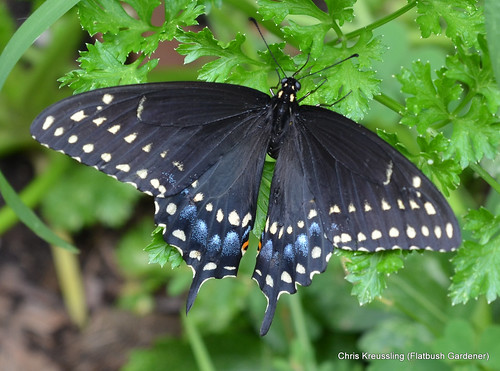
This is a female Eastern Black Swallowtail Butterfly, Papilio polyxenes. I caught her at the moment she discovered our group of parsley plants (Petroselinum hortense, or P. crispum). She was laying eggs, carefully placing just one under separate leaves of two of the plants.
The eggs are tiny. For scale, my thumbnail is about 1/2″ wide.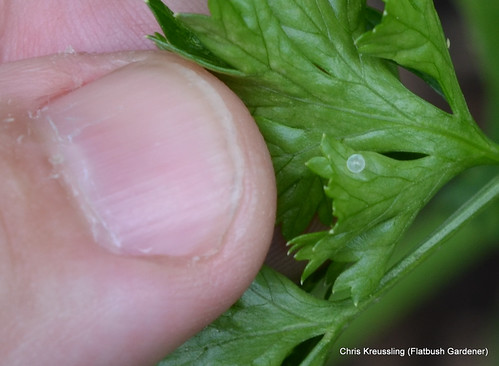
Eastern Blacks are members of a mimicry complex that includes several other species of large, black or dark brown swallowtails with spots and blue iridescence:
The beautiful Pipevine Swallowtail, Battus philenor, is the model of a Batesian mimicry complex. The members of this complex present a confusing array of blue-and-black butterflies in the summer months in the eastern United States. These include the Spicebush Swallowtail, Black Swallowtail (female), Tiger Swallowtail (dark phase, female), Red-spotted Purple and Diana Fritillary (female).
There is some indication that the Spicebush and Black Swallowtails are also distasteful, so the complex is partly Mullerian as well. In the central and western US, Old World Swallowtail (Papilio machaon, form bairdi), Indra Swallowtail (Papilio indra), and Ozark Swallowtail (Papilio joanae) have dark blue/black forms, probably mimics of the Pipevine Swallowtail.
– BugGuide: Battus philenor – Pipevine Swallowtail
Fortunately, several species in this complex have strong preferences for host plant families: Spicebush prefers Laureaceae, Pipevine prefers Aristolochiaceae. Knowing that the host plant, parsley, is in the Apiaceae, the Carrot/Dill Family, made it easy to quickly identify this butterfly, as the Black prefers plants in this family.
When we returned from vacation, the caterpillars had already hatched. Most of them were big! But some were still underdeveloped. I counted 14 overall.
Their appearance changes dramatically as they mature through each instar, or molting.
In the final stage, they are supposed to be mostly green. Several have reached that stage. I’m anxiously waiting for them to form chrysalises. And then, new butterflies! But probably not until next year, as they overwinter as chrysalises, and it’s getting late in the year.
If you have ever wondered how your vegetable plant could get denuded overnight, watch this video of one of the caterpillars feeding. The speed has not been modified, time-lapsed, or sped up. They eat fast!
Update, 2012-09-10
Most of the celery leaves are gone. The plants themselves have survived, and new leaves are emerging from their centers.
Their numbers gradually dwindled since I wrote this post. I couldn’t tell if they were leaving to seek a new food source, or to pupate.
By yesterday, only two large caterpillars remained. I observed one of them leave the plant and start to climb the frame of the raised bed. There was nothing for it where it was heading, so I moved it to part of one plant where leaves remained. It didn’t start feeding, as I expected. Instead, it took off in the opposite direction, toward the tomato plants.
I intervened a second time. This time, I removed it to the backyard, where I’m growing Zizia aurea, a native plant in the Apiaceae, in a mixed border. Even if it wasn’t going to feed any more, there are more options of plants, including shrubs, for it to climb and pupate. The disadvantage is that the backyard is much shadier.
Only one caterpillar remains. Soon it will set out on its own, as well, and this adventure will be over, for this year.
My plan for next year is to move some of the Zizia to ground adjacent to the raised bed. I’m hoping both that the it will thrive in a sunnier location, and that the Swallowtails will prefer it as a host plant. We will see.
[goo.gl]
Related Content
Flickr photo set: Papilio polyxenes, Eastern Black Swallowtail
Gardening with the Lepidoptera, 2011-06-11

